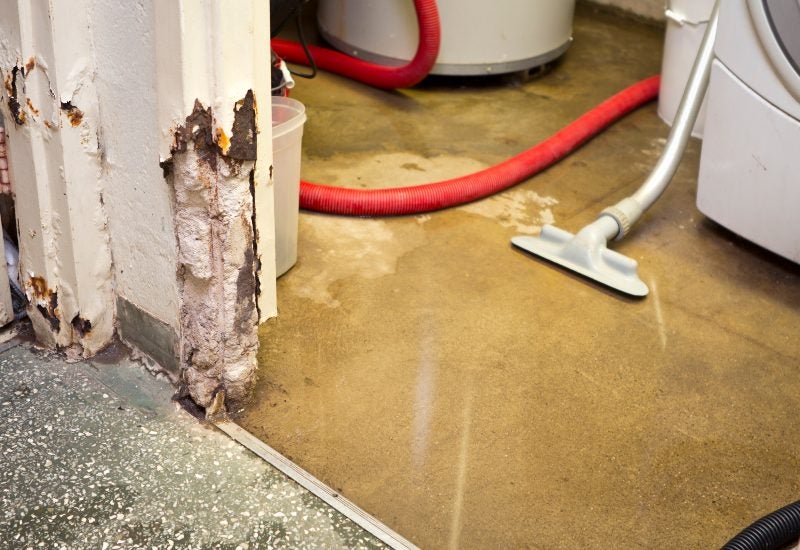Solutions to Prevent Basement Flooding by Triad Basement Waterproofing
It’s raining pretty hard, so you decide to check on the basement. Discovering water pouring in from the window wells or slowing rising from the floor is shocking, but don’t panic. Prompt action is the best way to mitigate property damage and salvage your belongings. Here’s how to address basement flooding and prevent future water intrusion.

What Causes Basement Flooding?
Basements can flood for several reasons. Common causes include:
- Heavy rainfall: When intense rain over-saturates the soil around your home, the excess water may flow into your basement, especially if your property has poor drainage.
- Faulty sump pump: A sump pump is your first line of defense against basement flooding. If the pump fails due to a power outage, mechanical failure, or improper maintenance, water can quickly rise.
- Poor drainage: Clogged or improperly installed gutters and downspouts can cause water to spill over and collect near your basement, leading to floods. Soil that slopes toward your foundation rather than away from it is also an issue.
- Leaks: Cracked basement walls and floors allow rising groundwater to seep in. These leaks can form due to hydrostatic pressure from the soil outside your basement, especially after heavy rains or snow melts.
- Sewer backup: During heavy rainfall, municipal sewer systems can become overwhelmed, causing water to back up through the sewer lines. This can lead to sewage and water flowing into your basement through drains and toilets, posing serious health risks.
What to Do If Your Basement Has Flooded
Act promptly to minimize the damage from a flooded basement. Here’s what to do if your basement floods:
- Cut the power: To eliminate electrical hazards, turn off the power to the basement from your home’s main electrical panel. If you can’t access the panel safely or it’s located in the basement, call an electrician or your utility company for assistance.
- Identify where the water is coming from and stop it: If the flooding stems from a burst pipe, turn off your home’s main water supply. If the water is entering through foundation cracks, temporary sandbagging and waterproof taping may help.
- Take proper safety precautions: Wear rubber boots and gloves to safeguard against contaminated water. Remember, floodwater can contain harmful bacteria, chemicals, or sewage, so calling a professional for flooded basement cleanup is wise.
- Pump water from the basement: A sump pump can pump out large volumes of water. Direct standing water to the sump pit using a push broom, and the pump will do the rest. If you don’t have a sump pump, rent a wet-dry shop vac or pool pump. Direct the water into a drain, not your yard, where it will only further saturate the soil.
- Remove wet items: Take wet carpets, furniture, and boxes to a well-ventilated area to dry out. Sorting through these items quickly is important; some belongings may be salvageable, while others might need to be discarded due to water damage or mold growth.
- Air out and dry the basement: Good ventilation is the key to drying out a flooded basement. Use fans and dehumidifiers to circulate air and remove moisture. Only open windows if it’s dry outside to avoid introducing more humidity.
- Clean, sanitize, and deodorize: After the basement is dry, thoroughly clean and disinfect all surfaces to prevent mold. Clean nonporous surfaces with water and detergent, and sanitize with bleach to kill lingering bacteria. Porous materials may need to be professionally cleaned or discarded.
Prevent Future Basement Flooding
One instance of basement flooding is one time too many. Here’s how to fortify your basement against future water threats:
- Test your sump pump: Check the pump before the rainy season starts by pouring water into the sump pit. The pump should activate, pump out water, and turn off automatically. Consider a battery backup to ensure your sump pump works during power outages.
- Clean your gutters and downspouts: Clear leaves and debris from the gutters every spring and fall. Then, extend downspouts at least three feet away from your home to prevent water from pooling around the foundation.
- Install window well covers: Window wells can collect rainwater and snow, which then seep into your basement. Clear, domed window well covers allow light to enter while keeping out water, leaves, and debris.
- Invest in basement waterproofing: Waterproofing your basement reduces the risk of flooding. Interior waterproofing involves applying sealants, installing a drain tile system, and using a dehumidifier. Exterior waterproofing may include grading the soil, applying waterproof coatings or membranes to exterior walls, and installing pumps or French drains.
Contact Triad Basement Waterproofing in Gaithersburg, MD
At Triad Basement Waterproofing, we know nothing is more stressful than a flooded basement. Our local, family-owned business offers state-of-the-art, cost-effective solutions to keep your basement dry and safe. With over 35 years of experience, our licensed, bonded, and insured professionals ensure top-quality service with a personal touch. Plus, we stand by our work with industry-leading warranties for your peace of mind. Contact us at (301) 532-7903 for a free basement flooding repair or waterproofing estimate in Gaithersburg, MD.
